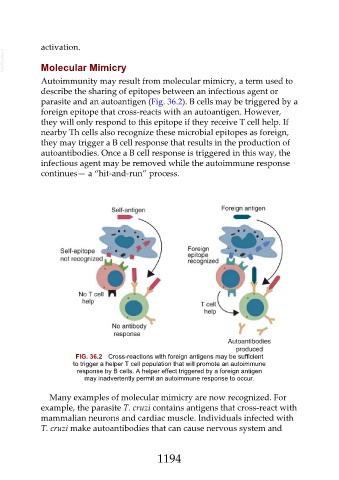Page 1194 - Veterinary Immunology, 10th Edition
P. 1194
activation.
VetBooks.ir Molecular Mimicry
Autoimmunity may result from molecular mimicry, a term used to
describe the sharing of epitopes between an infectious agent or
parasite and an autoantigen (Fig. 36.2). B cells may be triggered by a
foreign epitope that cross-reacts with an autoantigen. However,
they will only respond to this epitope if they receive T cell help. If
nearby Th cells also recognize these microbial epitopes as foreign,
they may trigger a B cell response that results in the production of
autoantibodies. Once a B cell response is triggered in this way, the
infectious agent may be removed while the autoimmune response
continues— a “hit-and-run” process.
FIG. 36.2 Cross-reactions with foreign antigens may be sufficient
to trigger a helper T cell population that will promote an autoimmune
response by B cells. A helper effect triggered by a foreign antigen
may inadvertently permit an autoimmune response to occur.
Many examples of molecular mimicry are now recognized. For
example, the parasite T. cruzi contains antigens that cross-react with
mammalian neurons and cardiac muscle. Individuals infected with
T. cruzi make autoantibodies that can cause nervous system and
1194

